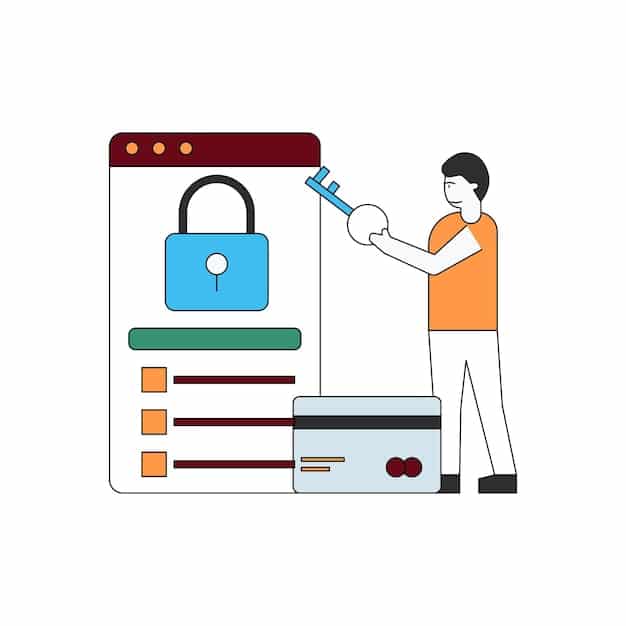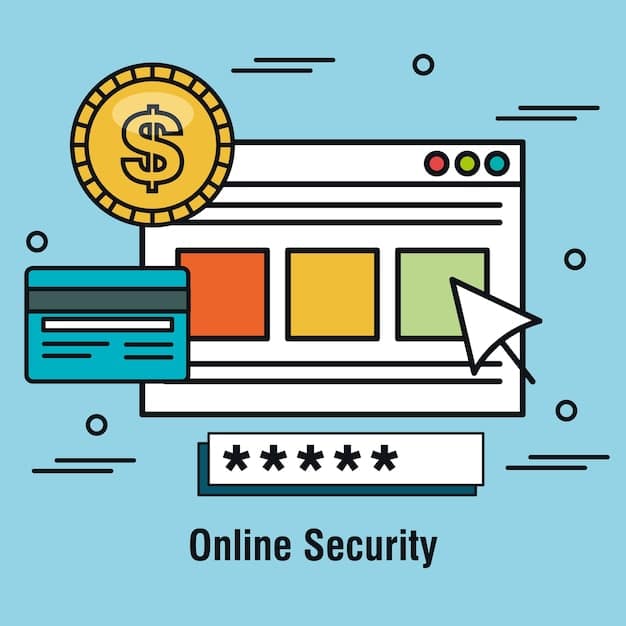Payment Gateway Integration: A Step-by-Step Guide for US E-commerce Businesses

Payment gateway integration is a critical process for US e-commerce businesses, ensuring secure and seamless online transactions, and requiring careful planning and execution to optimize customer experience and protect sensitive data.
Navigating the world of e-commerce in the US requires a solid foundation, and a key part of that is understanding payment gateway integration. This guide offers a step-by-step approach for US e-commerce businesses to ensure secure and efficient online transactions.
Understanding Payment Gateways
Before diving into the integration process, it’s essential to understand what a payment gateway is and its critical role in e-commerce. A payment gateway securely transmits transaction data between your e-commerce platform and the payment processor.
Think of it as the cashier in a brick-and-mortar store, but for online transactions. It verifies customer payment details, encrypts sensitive information, and authorizes or declines transactions in real-time.
Why is a Payment Gateway Important?
Implementing a robust payment gateway is crucial for several reasons:
- Security: Protects customer data and prevents fraud.
- Customer Trust: Builds confidence and encourages repeat business.
- Efficiency: Streamlines the payment process for a smooth checkout experience.
- Compliance: Helps meet PCI DSS (Payment Card Industry Data Security Standard) requirements.
Choosing the right payment gateway is a crucial decision for any US e-commerce business. Consider factors like transaction fees, supported payment methods, and integration capabilities.
Step 1: Choosing the Right Payment Gateway
Selecting the appropriate payment gateway is a fundamental step in building a successful e-commerce business. The ideal choice depends on several factors, including your business model, target audience, and technical capabilities.
Many options are available, each with different features, pricing structures, and integration methods. Evaluate your business needs and research available options thoroughly.

Popular Payment Gateways in the US
Some of the most popular payment gateways for US e-commerce businesses include:
- Stripe: Known for its developer-friendly API and comprehensive features.
- PayPal: A widely recognized and trusted payment platform with a large user base.
- Authorize.net: A long-standing gateway offering robust security and advanced features.
- Square: A versatile option suitable for both online and offline sales.
Ultimately, the best payment gateway is the one that aligns perfectly with your business needs and provides a seamless experience for your customers.
Step 2: Understanding Integration Methods
Once you’ve chosen a payment gateway, the next step focuses on understanding the different integration methods. Each gateway offers multiple paths for connecting to your e-commerce platform.
There are two main types of integration: hosted payment pages and direct API integration. The method you choose will impact both the user experience and your security responsibilities.
Hosted Payment Pages
With hosted payment pages, customers are redirected from your website to the payment gateway’s secure server to complete their transaction. After payment, they are redirected back to your site.
This method is generally easier to implement and reduces your PCI compliance burden, as you do not handle sensitive payment data directly.
Direct API Integration
Direct API integration allows you to keep customers on your website throughout the entire checkout process. However, this method requires more technical expertise and places a greater responsibility on you for PCI compliance.
It provides greater control over the user experience but demands strong security measures and ongoing maintenance.
Step 3: Setting Up Your Payment Gateway Account
With your chosen gateway and integration method in mind, you need to set up your payment gateway account. This is a crucial step and usually involves providing detailed information about your business.
The setup process varies depending on the gateway but typically includes creating an account, verifying your business details, and configuring security settings.
- Provide accurate business information for verification.
- Set up security measures like two-factor authentication.
- Configure notification settings for transaction alerts.
Make sure you thoroughly review all the terms and conditions before finalizing your account setup. Understanding the fee structure, payout schedule, and any potential limitations is essential.
Step 4: Integrating the Payment Gateway with Your E-commerce Platform
This is where the actual integration takes place, connecting the payment gateway to your e-commerce platform. The process will vary depending on the platform you use, such as Shopify, WooCommerce, or Magento.
Most platforms offer plugins or extensions that simplify the integration process. Follow the payment gateway’s documentation and your platform’s instructions carefully.

Using Plugins and Extensions
For platforms like WordPress (with WooCommerce), there are numerous plugins available that streamline the integration process.
These plugins provide a user-friendly interface for configuring your payment gateway settings and managing transactions within your WordPress dashboard.
Testing the Integration Thoroughly
After integration, thorough testing is essential to ensure everything works correctly. Use test credit card numbers provided by the payment gateway to simulate successful and failed transactions.
Check for errors, payment processing delays, and ensure all data is being transmitted securely.
Step 5: Ensuring Security and PCI Compliance
One of the most critical aspects of payment gateway integration is ensuring security and adhering to PCI DSS compliance standards. This protects your customers and your business from fraud and data breaches.
Implement SSL certificates, use strong passwords, and keep your software updated. Staying ahead of potential security threats is paramount.
- Install an SSL certificate to encrypt data transmission.
- Implement strong security measures to protect customer data.
- Regularly update your payment gateway software and plugins.
Consider working with a security consultant to assess your systems and ensure you meet all necessary compliance requirements. Regular security audits can help identify and address vulnerabilities.
Step 6: Monitoring and Optimizing Your Payment Gateway
Once your payment gateway is integrated and operational, the process doesn’t end there. Continuous monitoring and optimization are essential for maintaining a smooth and efficient payment processing system.
Keep an eye on transaction success rates, identify any recurring errors, and make adjustments as needed.
- Closely monitor transaction success rates to identify issues.
- Analyze customer feedback and address any payment-related concerns.
- Optimize the checkout process for improved conversion rates.
Regularly review your payment gateway settings, including transaction limits and fraud prevention rules, to ensure they align with your business needs and security policies.
| Key Point | Brief Description |
|---|---|
| ✔️ Choosing a Gateway | Select a gateway that suits your business needs and target audience. |
| ⚙️ Integration Methods | Understand hosted pages vs. direct API integration. |
| 🔒 Security & PCI | Ensure strong security and PCI DSS compliance to protect data. |
| 📈 Monitoring | Continuously monitor transaction success rates and optimize the payment process. |
Frequently Asked Questions
▼
A payment gateway is a service that authorizes credit card or direct payments processing for e-businesses and online retailers. It’s important because it secures transaction data and ensures smooth payment processing.
▼
The main integration methods are hosted payment pages, where customers are redirected, and direct API integration, which keeps customers on your site but requires more security measures.
▼
Consider factors like transaction fees, supported payment methods, integration ease, and security features. Research and compare popular options like Stripe, PayPal, and Authorize.net.
▼
PCI DSS (Payment Card Industry Data Security Standard) is a set of security standards designed to protect credit card data. Compliance is essential for safeguarding customer information and avoiding penalties.
▼
Use SSL certificates, implement strong security measures to protect customer data, regularly update software, and consider working with a security consultant for audits and compliance.
Conclusion
Integrating a payment gateway is a crucial step for any US e-commerce business looking to ensure secure and efficient online transactions. By following this step-by-step guide and prioritizing security and customer experience, you can build a solid foundation for your online success.





